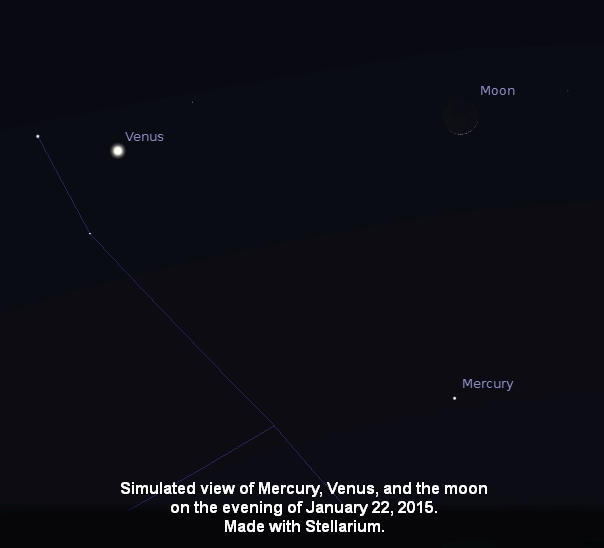¡SkyCaramba! Weekly astronomy blog for the week ending January 17, 2015
After their close call in our evening skies on January 10th and 11th, Venus and Mercury pull apart. Venus will be a presence in our evening skies until July. But Mercury is closer to the sun. So it orbits faster. By the end of this month, it will be in conjunction with the sun on its way to becoming a morning object.
So if you want to see Mercury, you have to be more diligent about taking advantage of the opportunity. Often, the planet is so close to the horizon, it’s hard to see between trees and buildings. Sometimes you have to find it through haze and distant clouds. And even when the horizon is clear, twilight and a partial view of the constellations in its direction make it hard to identify with certainty.
It helps when something else unmistakable is nearby. Some people have mistaken Venus for distant lights from buildings and aircraft. The planet is occasionally taken for a spacecraft purportedly from another planet. But if you know how to identify Venus, it provides a good guide for seeing Mercury the first two weeks of this month.
Venus and Mercury are still somewhat close on the 21st when a thin crescent moon passes by. Venus will be the brighter of the two planets and it is above Mercury. The moon is to the right.
Let’s explain here that the moon’s age is measured from the time of new moon. At the moment of new moon, the moon is 0 hours old. An hour later, it’s 1 hour old. Some moon watching enthusiasts like to see the moon as early as possible.
A French astronomer succeeded in photographing a crescent at the moment of new moon in July 2013. Since the moon wasn’t passing directly in front of the sun, an extremely thin crescent showed up in the picture. Apart from seeing the moon’s silhouette during a solar eclipse, the record for the youngest naked eye moon sighting may belong to two British women who claimed to have seen a crescent just under 15 hours old in 1916. As with so many records, some people doubt the story.
This month’s new moon happens at 13:14 Universal Time on January 20th. More than a full day will pass before it passes Mercury, so you shouldn’t have much trouble seeing it in clear skies. The moon will be 26 hours old when it is closest to Mercury, about 2° away, on January 21st at about 15:00. It passes Mercury in just a few hours. On the 22nd at about 01:00, the moon is almost 36 hours old, and the crescent will be in an isosceles triangle with the planets. The moon forms a right angle in a moon-Venus-Mercury configuration as it passes Venus at about 06:30 UT on January 22nd.
As a special treat, watch a slightly thicker crescent pass Mars the next night. Venus and Mercury will be noticeably farther apart then. Try to spot Mercury every evening until it disappears in the sun’s dusky glow.
¡SkyCaramba!
